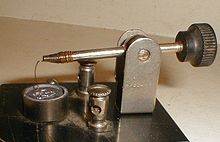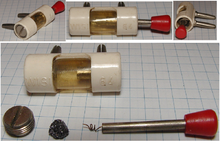Crystal detector: Difference between revisions
JA.Davidson (talk | contribs) m →Developments and eventual replacement: fix broken link |
m →Crystal: punctuation correction. |
||
| Line 11: | Line 11: | ||
A [[natural]] [[mineral]] [[crystal]] forms the semiconductor side of the junction. Today the most common crystal used is [[galena]], a naturally occurring [[sulfide]] [[ore]] of [[lead]] and a semiconductor with a small bandgap of about 0.4 eV, used without treatment directly as it is mined. Galena with good detecting properties is rare and has no reliable visual characteristics distinguishing it from galena samples with poor detecting properties. A rough pebble of detecting mineral about the size of a pea was mounted in a metal cup. Because the relatively high temperature of tin-lead [[Solder|solder]] can damage many crystals, the crystal was often mounted in a low melting point (well under 200 degrees F) metal such as [[Wood's metal]]. One surface was left exposed to allow contact with the cat's whisker wire. |
A [[natural]] [[mineral]] [[crystal]] forms the semiconductor side of the junction. Today the most common crystal used is [[galena]], a naturally occurring [[sulfide]] [[ore]] of [[lead]] and a semiconductor with a small bandgap of about 0.4 eV, used without treatment directly as it is mined. Galena with good detecting properties is rare and has no reliable visual characteristics distinguishing it from galena samples with poor detecting properties. A rough pebble of detecting mineral about the size of a pea was mounted in a metal cup. Because the relatively high temperature of tin-lead [[Solder|solder]] can damage many crystals, the crystal was often mounted in a low melting point (well under 200 degrees F) metal such as [[Wood's metal]]. One surface was left exposed to allow contact with the cat's whisker wire. |
||
Other minerals were also used; significant among them was [[iron disulfide]] (pyrite or " |
Other minerals were also used; significant among them was [[iron disulfide]] (pyrite or "fool's gold"). Many of the earlier noteworthy mineral detectors did not use the cat's whisker configuration, such as [[Vitreous|vitreous]] [[silicon]], [[silicon carbide]] (carborundum) and a [[zincite]]-[[bornite]] rock-to-rock junction. |
||
=== Whisker === |
=== Whisker === |
||
Revision as of 10:46, 5 October 2008


Cat’s whisker refers to a thin wire that lightly touches a semiconducting crystal to make an imperfect contact-junction detector in a crystal radio. While originally a figurative description of a mechanical part, the term grew to encompass the entire detector assembly and also in some English speaking communities to describe the receiver itself.
Description
As a detector it is simply a relatively primitive and unstable metal–semiconductor point-contact junction forming a Schottky barrier diode. It is based on the discovery of the semiconductor or "point rectifier effect" by Ferdinand Braun, a German physicist and radio pioneer, in 1874 at the University of Würzburg. Based on this work G.W. Pickard developed the cat's whisker diode using a silicon crystal, which was patented in 1906.
Crystal
A natural mineral crystal forms the semiconductor side of the junction. Today the most common crystal used is galena, a naturally occurring sulfide ore of lead and a semiconductor with a small bandgap of about 0.4 eV, used without treatment directly as it is mined. Galena with good detecting properties is rare and has no reliable visual characteristics distinguishing it from galena samples with poor detecting properties. A rough pebble of detecting mineral about the size of a pea was mounted in a metal cup. Because the relatively high temperature of tin-lead solder can damage many crystals, the crystal was often mounted in a low melting point (well under 200 degrees F) metal such as Wood's metal. One surface was left exposed to allow contact with the cat's whisker wire.
Other minerals were also used; significant among them was iron disulfide (pyrite or "fool's gold"). Many of the earlier noteworthy mineral detectors did not use the cat's whisker configuration, such as vitreous silicon, silicon carbide (carborundum) and a zincite-bornite rock-to-rock junction.
Whisker
The metal cat's whisker forms the metal side of the junction, which is merely a springy piece of thin metal wire (phosphor bronze was common), mounted in a suitable holder so that the entire exposed surface of the crystal can be probed from many directions to try and find the most sensitive working junction. This requires some skill and a great deal of patience; even then a good contact can easily be lost by the slightest vibration.
Developments and eventual replacement
When these devices were in common use, more advanced proprietary versions of "permanent" detector were developed, many of them by G. W. Pickard. One consisted of various combinations of pairs of different crystals such as Zincite touching Bornite or Chalcopyrite, in fairly heavily spring-loaded contact. This variation was known as the Perikon detector, a pseudo-rebus derivation from "perfect Pickard contact" that also sounds like "pair of contact detectors". Other detectors patented by Pickard included the common crystal iron pyrite. Pickard has the distinction of having brought silicon into use as a detector, patenting it in 1906. At nearly the same time, General Henry Harrison Chase Dunwoody patented the use of silicon carbide (carborundum), an artificial substance created accidentally during attempts by Edward Acheson to create diamonds.
Use of mineral detectors was largely superseded by the development of vacuum tube detectors, although the expense of the latter meant that full replacement took several decades.
The point-contact Si detector was subsequently resurrected because of the military requirement for microwave radar. Vacuum tube detectors do not work at microwave frequencies. Even the semiconductor p-n junction detectors may not be fast enough compared to semiconductor point contact detectors because of minority carrier storage problem, and large capacitance if the area is not small enough. Of course, primitive cat-whisker detectors are obsolete now, but modern point-contact Si detectors are still commercially available. For example, Advanced Semiconductor Inc. (North Hollywood, California, USA) is selling Si point contact detectors which will cover from UHF (ultra high frequency) to 16 GHz. Thus the approach pioneered by Ferdinand Braun and Greenleaf Whittier Pickard is still very much alive today.
Advertisement of primitive cat's-whisker detectors for hobbyists can still be found, for example, by searching the Internet. Two examples are shown in two photographs within this article.
See also
- List of historic technological nomenclature
- Reginald Fessenden
- barretter detector
- electrolytic detector
External links
Patents
- U.S. patent 836,531 - Means for receiving intelligence communicated by electric waves (silicon detector), Greenleaf Whittier Pickard, 1906
- U.S. patent 837,616 - Wireless telegraph system (silicon carbide detector), Henry H.C. Dunwoody, 1906
- U.S. patent 906,991 - Oscillation detector (multiple metallic sulfide detectors), Clifford D. Babcock, 1908
- U.S. patent 912,613 - Oscillation detector and rectifier ("plated" silicon carbide detector with DC bias), G.W. Pickard, 1909
- U.S. patent 912,726 - Oscillation receiver (fractured surface red zinc oxide (zincite) detector), G.W. Pickard, 1909
- U.S. patent 933,263 - Oscillation device (iron pyrite detector), G.W. Pickard, 1909
- U.S. patent 1,118,228 - Oscillation detectors (paired dissimilar minerals), G.W. Pickard, 1914
General
- Crystal and Solid Contact Rectifiers 1909 publication describes experiments to determine the means of rectification (PDF file)
- Radio Detector Development from 1917 The Electrical Experimenter
- The Crystal Experimenters Handbook 1922 London publication devoted to point contact diode detectors. (PDF file courtesy of Lorne Clark via http://www.earlywireless.com)
